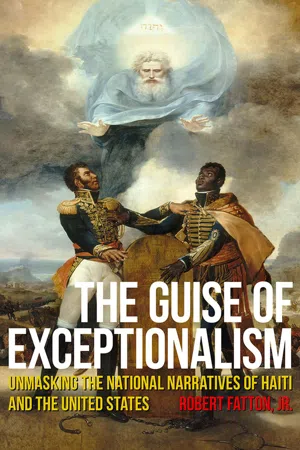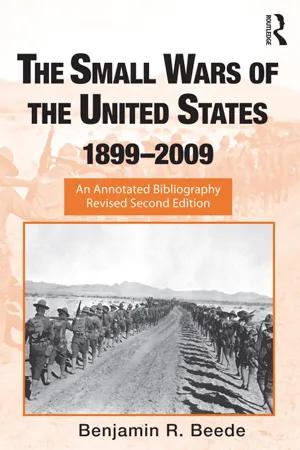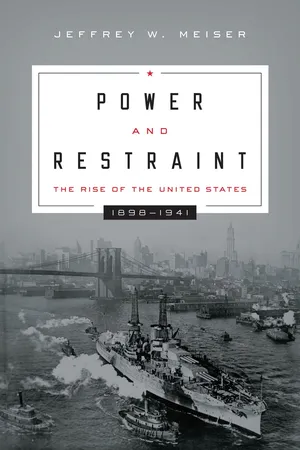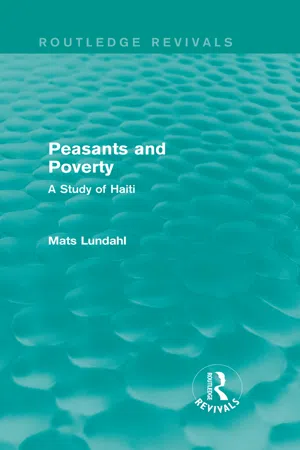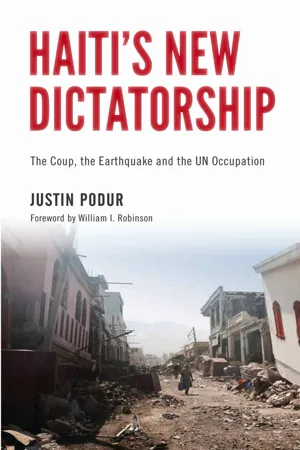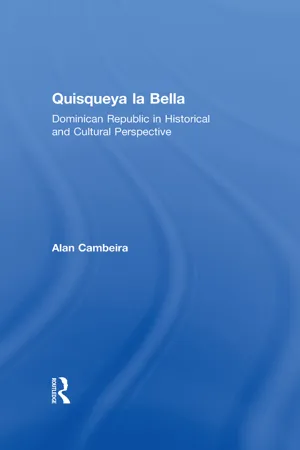History
US Occupation of Haiti
The US occupation of Haiti refers to the period from 1915 to 1934 when the United States military intervened in Haiti. This intervention was prompted by political instability and economic interests. During this time, the US implemented various reforms and infrastructure projects, but also faced resistance from Haitian nationalists. The occupation had a lasting impact on Haiti's political and economic development.
Written by Perlego with AI-assistance
Related key terms
8 Key excerpts on "US Occupation of Haiti"
- eBook - ePub
The Guise of Exceptionalism
Unmasking the National Narratives of Haiti and the United States
- Robert Fatton(Author)
- 2021(Publication Date)
- Rutgers University Press(Publisher)
CHAPTER 5The American Occupation and Haiti’s Exceptionalism
Whatever may have been the reasons advanced by Washington policy makers for the takeover of Haiti in 1915, it is clear that the American occupation had at best very limited success achieving its transformative goals. In fact, while it introduced modest infrastructural improvements in terms of roads and communications, it was marked by significant repression of local resistance movements.1 The most important legacy of the occupation was the centralization of power in Port-au-Prince through the creation of a more effective state bureaucracy, and more significantly, a national army. The army circumscribed the powers of regionally based armed bands controlled by “big men” and established a modicum of political order.Political order, however, did not imply popular acquiescence. It is true that many in the traditional Haitian elites initially collaborated with and even welcomed the occupiers. Many of these collaborators had authoritarian reflexes and shared some of the paternalistic and racist ideology of their American overlords. Convinced that Haitians were not prepared for any democratic form of self-government, these elites believed in the despotisme éclairé des plus capables (“enlightened despotism of the most capable”). In fact, despotisme éclairé had a double meaning: not only did it allude to intellectual enlightenment, but it also conveyed the veiled racist message that rule by the light-skinned minority was superior to that of the black majority.2 Thus, from their privileged class status and collaborationist position, Haitian rulers under the American occupation regarded the rest of their black compatriots—especially the peasantry—with contempt. This contempt reflected one of the fundamental contradictions of Haitian exceptionalism; it has always celebrated the blackness and Africanness of its citizens as proud descendants of Ginen, and yet it never managed to free its ruling class from powerful remnants of colonial racism, especially the Creole’s denigration of the African-born slave as Bossal - eBook - ePub
The Small Wars of the United States, 1899-2009
An Annotated Bibliography
- Benjamin R. Beede(Author)
- 2012(Publication Date)
- Routledge(Publisher)
XI
Haiti, 1915–34
American intervention in Haiti was one of the most controversial of the small wars of the United States, and it may have been among the bloodiest.A significant amount of fighting occurred in 1915–16 and 1918–20. Rioting occurred in 1929, and it helped bring about the United States withdrawal. Aircraft and motor vehicles were employed, but much of the marine service consisted of foot or mounted patrols in the jungle. As in many other countries where its forces were present, the United States formed a constabulary.The State and Navy departments made a considerable investment in Haiti. While there was no military government, the Navy Department did operate government bureaus for some time. Despite efforts to improve life in Haiti and to introduce democracy, the United States impact ultimately was rather limited.Chronology
1915 July 28 United States marines begin landing in Haiti. Continued disorder in that country concerned the Wilson administration, owing to fears that third countries might intervene. August Some Haitians began a guerrilla campaign against occupying United States forces, a conflict that lasted until September 1916. Resistance of another sort was demonstrated by the Union Patriotique that was established the same month. That organization, representing the point-of-view of the Haitian elite, was an effective voice in Haiti and in the United States against the occupation, and it continued its existence until the United States withdrawal in 1934. August 24 Haiti and the United States signed a Gendarmerie Agreement that provided for the establishment of a paramilitary police force under United States direction to replace the former Haitian army. The force, initially known as the Garde d’ Haiti, eventually became the Gendarmerie d’ Haiti - eBook - ePub
- Shalini Puri, Lara Putnam, Shalini Puri, Lara Putnam, Shalini Puri, Lara Putnam(Authors)
- 2017(Publication Date)
- Palgrave Macmillan(Publisher)
Women in Haiti capitalized on the nation’s altered transportation landscape and the disruption of public space to manage their economic, social, and political lives during the period. As evidenced in Marie Louise’s letter, the occupied thoroughfares revealed the complexities of infrastructural development. Traffic on the streets and bridges of Haiti blurred the boundaries between occupied and occupiers, simultaneously revealing extreme social and political anxieties of the period and also facilitating exchanges in which women challenged and complied with the US military invasion.US Marines arrived in Haiti on July 28, 1915. The military occupation was characterized as the Caribbean frontier of World War One. According to US President Woodrow Wilson’s administration, Haiti’s weak state structure, its proximity to the US, and the prevalence of German merchants made the nation a potential breeding ground for anti-Allied forces. This regional concern for Allied interests was coupled with the paternalistic belief that Black Haitians were uncivilized and incapable of governing their own nation. As good neighbors, the US would use the military occupation to strengthen Haiti’s political and physical infrastructure through government restructuring, the implementation of martial law (1918), and the construction of schools, roads, and bridges.4In the first decade of the occupation the US celebrated the construction and reconstruction of over 500 miles of roads, bridges, and railways.5 This productive period of infrastructural development and reforms coincided with the most violent era of the occupation.6 Much of the violence was directly related to the development process governed by the corvée system. Under this system, individuals accused of a crime or those who failed to pay their property taxes could be forced to work on government construction projects without compensation, bringing harsh labor, long work hours, injury, even death. The brutality of the corvée system heightened frustrations and discontent with the American presence and encouraged Haitians to swell the ranks of anti-occupation movements, including the more politically oriented Union Patriotique - eBook - ePub
Power and Restraint
The Rise of the United States, 1898–1941
- Jeffrey W. Meiser(Author)
- 2015(Publication Date)
- Georgetown University Press(Publisher)
First, the perceived threat to the Panama Canal receded after World War I. Second, it appeared that some American goals, such as financial reform and the establishment of a US-trained Haitian National Guard, had succeeded. Third, it was unlikely that extending the occupation would yield much additional gain. Fourth, the American public had come to view “foreign commitments … as threats from which we should disengage ourselves as rapidly as possible. The occupation of Haiti, on these terms, became a ‘horrible example’orather than a fertile field for altruistic experiments.” 47 For example, the occupation of Haiti was used by Japan as justification for its territorial aggrandizement in East Asia. Fifth, Haitian opposition to occupation fostered American withdrawal. Cooper also cites a 1958 personal letter from Dana Munro where the former ambassador to Haiti gives his own explanation for the end of the occupation: I think that the most important factor in the decision to withdraw from Haiti was President Hoover’s dislike of military interventions. “Anti-imperialist” criticism of our Caribbean policy in the United States had of course been influencing the policies of the State Department ever since 1921, but I don’t believe that it had so much effect on Mr. Hoover as did his own personal convictions…. I doubt whether European criticism had much effect, and the State Department was rather insensitive before 1933 to Latin American criticism. 48 The perceived benefits of occupying Haiti were decreasing as the domestic political cost of occupation was increasing. The Hoover administration prepared the foundation for withdrawal, but it took Roosevelt’s election to finally end the occupation. Roosevelt made the final decision to reduce US financial control in Haiti, but more importantly he signaled a new era of American respect for the smaller republics of the Western Hemisphere - eBook - ePub
Peasants and Poverty (Routledge Revivals)
A Study of Haiti
- Mats Lundahl(Author)
- 2015(Publication Date)
- Routledge(Publisher)
6 The peasants were left to solve their own problems.The Occupation: First Efforts at Economic Development
During its first seven years, from 1915 to 1922, the American occupation of Haiti had only a negligible impact on agriculture. The period was one of pacification and adjustment, not one of constructive efforts. The emphasis lay on the military aspects of administration while the civilian side was lagging behind. The main achievement was the establishment of peace and order, so sadly lacking before 1915. Some road construction and repair was carried out, but the trails on which a majority of the agricultural population depended for communication with market-places were left almost untouched. Repair of irrigation works, which had been deteriorating after the French had left the island was begun.In 1922, the occupation entered a more constructive phase which lasted until the 1929 student strikes and subsequent riots that led to the American withdrawal in 1934. Within the narrow confines drawn by the priority given to debt management (to be dealt with in Chapter 8 ) the Americans began a development program which, however limited, was the most ambitious that Haiti had ever experienced. ‘It was fully realized that Haiti’s future prosperity depends upon the development of her soil,’ wrote the American High Commissioner in his yearly report for 1924. ‘It therefore appeared essential that a well-drawn plan of agricultural development, comprising not only research and experiment but also theoretical and practical instruction in agriculture, be drafted. Vocational and manual training were also included in the plan.’7 - eBook - ePub
Haiti's New Dictatorship
The Coup, the Earthquake and the UN Occupation
- Justin Podur(Author)
- 2012(Publication Date)
- Pluto Press(Publisher)
7 and allowed the U.S. Navy to operate from Haitian ports to maintain the blockade of the South.THE U.S. MARINE OCCUPATION: 1915–34Saddled with these crippling debts, Haiti was hardly able to move forward. The mulatto elite’s Liberal Party fought the black National Party for control through the nineteenth century.8 There were military conflicts between rivals for power within Haiti, local revolts and rebellions, and border wars with the Dominican Republic. As U.S. economic power grew in the nineteenth century, so too did its influence in Haiti. By the 1910s, this influence was symbolized by HASCO, The Haitian-American Sugar Company. Like United Fruit in the Latin American ‘banana republics’, HASCO was a major player in Haitian politics and a vehicle for U.S. influence in the country.In 1915, the U.S. Marines invaded Haiti. As always, the U.S. cited local politics and concerns for its business interests (including HASCO) as the reason for invasion. But this was a period in which the U.S. conducted several invasions in the Americas (Nicaragua was occupied from 1912 to 1933, the Dominican Republic from 1916 to 1924, Cuba since the Spanish–American war, and others). The U.S. privatized the National Bank, re-instituted forced labour, tied resistance leader Charlemagne Peralte’s body to a door and circulated the photograph. When the Marines left 19 years later in 1934, the U.S. reserved a ‘special role’ for itself.9 The U.S. left behind two military forces for use against the population, the ‘gendarmerie’ and the National Guard, which evolved into the Haitian Army (renamed Forces Armees D’Haiti, or FADH, in 1958). In 1935, the post-occupation government of Haiti granted a 25-year banana contract to the U.S. Standard Fruit and Steamship Company.10 - eBook - ePub
- Mark T. Berger(Author)
- 2013(Publication Date)
- Routledge(Publisher)
As Don Bohning has put it in a major editorial in the Miami Herald : If Haiti is to continue as a functioning independent state, alternative options— including a period of international governance—need to be seriously contemplated to stem nearly two decades of unremitting political, economic and social deterioration. As unpalatable as it may be for the vast majority of Haitians… ceding temporary sovereignty to an international body is one option slowly gathering momentum. 66 While the idea that Haiti should come under the governance of an international trusteeship is not completely far-fetched given its thorough dependence on outside forces, it is unlikely to materialise; and, if it did, there is no reason to believe that it would succeed in improving the lot of the destitute majority. The US occupation of the country from 1915 to 1934 may have created a semblance of an infrastructure and a form of centralised government, but it contributed neither to long-term self-sustaining economic development nor to lasting democratic forms of accountability. In fact, while in some quarters there is a growing nostalgia for the good old days of colonialism, there is little to suggest that foreign dominance can end vicious historical cycles or unleash virtuous ones. 67 Paradoxically, this historical lesson seems to be accepted by strong advocates of the American empire - eBook - ePub
Quisqueya la Bella
Dominican Republic in Historical and Cultural Perspective
- Alan Cambeira(Author)
- 2016(Publication Date)
- Routledge(Publisher)
Even the most cursory overview of North American entanglement in the domestic affairs of various Latin American countries after the Spanish-American War (1898) reveals the evolving of a steadily aggressive interventionist policy. So the case of the Dominican Republic in 1916 was certainly not an altogether unrelated incident in the total scheme of things. The United States’ presence in the Caribbean Basin became immediately prominent upon official North American acquisition of the tropical island paradises of Cuba and Puerto Rico. The very brief but bitter Spanish-American War ended with the vanquished Spanish Crown having to surrender Cuba, Puerto Rico, and the Pacific islands of the Philippines to United States jurisdiction.These territories subsequently were transformed into colonial dependencies of Washington, D.C. As the Northern Colossus penetrated ever more deeply into the internal affairs of the individual islands of the Caribbean, the more it was perceived—at kast by Washington—that the route of military intervention in the region was essential for maintaining order and stability there. The United States military invasion and accompanying occupation of 1916–1924 in Quisqueya, therefore, was merely a key component of the rapidly emerging pattern of expanding North American political and economic hegemony in the Caribbean and Latin America generally. According to leading proponents of the widening role of North American capitalism during the era following the Spanish-American War, economic stability was regarded as the single basic tenet upon which any thoroughly modern, sophisticated nation could successfully be erected. All across the region, the United States had been fast positioning itself as mentor and master in terms of the ideal example for political and economic maturity. Direct United States intervention was thus inevitable once policymakers in Washington convinced themselves that solely by means of responsibly managing the finances of these countries could it then be feasible to restructure the existing political conduct—considered immature by North Americans—in the Caribbean.
Index pages curate the most relevant extracts from our library of academic textbooks. They’ve been created using an in-house natural language model (NLM), each adding context and meaning to key research topics.
